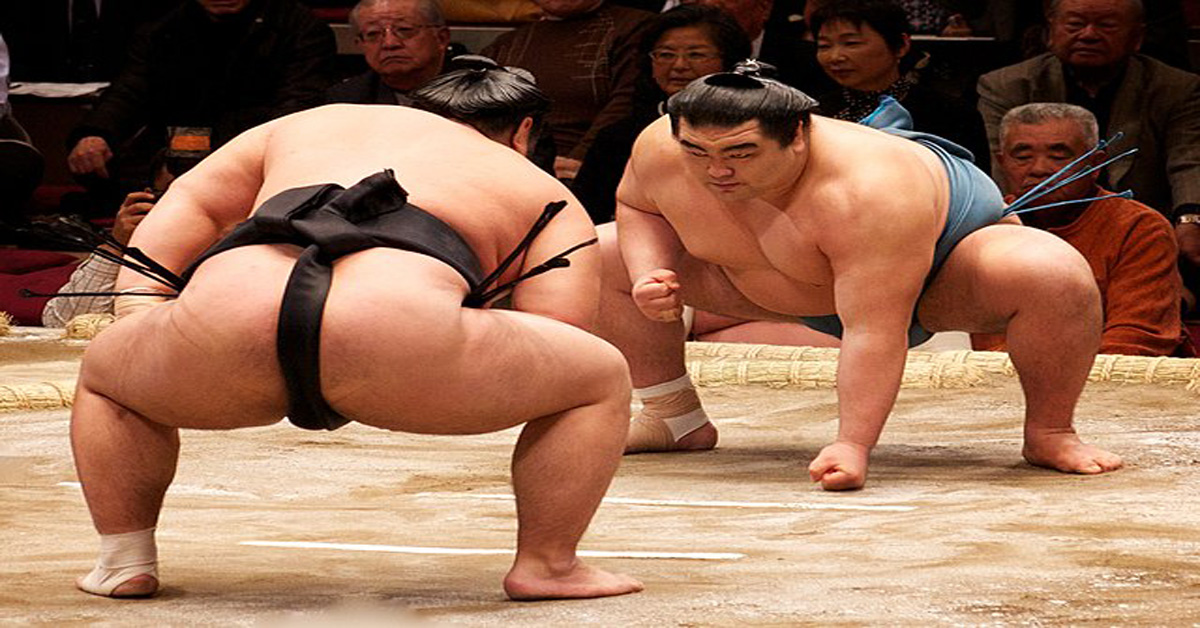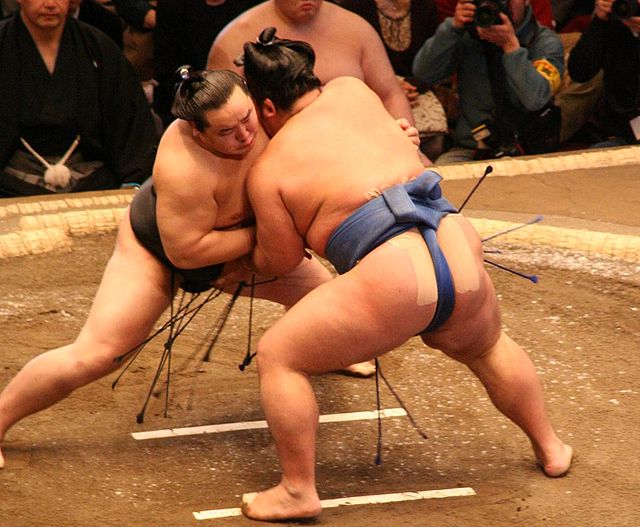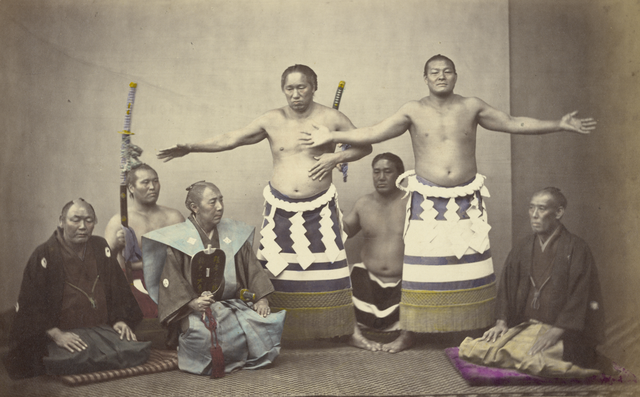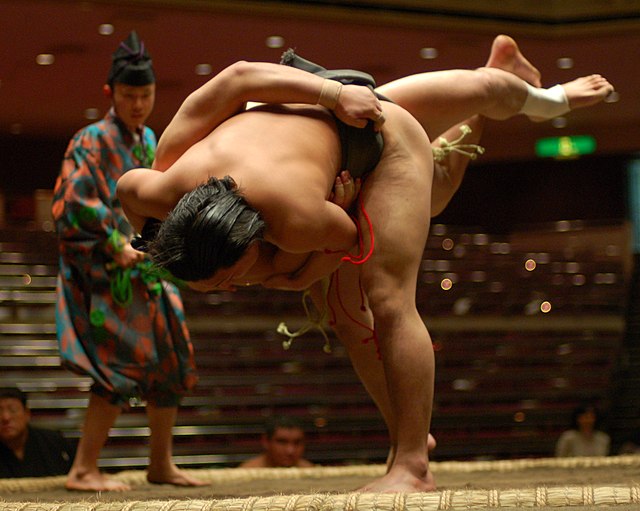
Sumo wrestling is a traditional Japanese sport engrained in Japan’s history and culture. It is one of the oldest running sports with a die-hard fan base who passionately follow this form of wrestling.
Here’s everything you need to know about the sport of sumo wrestling. Read below to learn the history of this exciting sport, its rules, and what it takes to become a sumo wrestler.

The History of Sumo Wrestling
Sumo wrestling dates back centuries to ancient Japan when the nation was formed. Originally, sumo was performed as a Shinto ritual.
This wrestling style would be performed at Japanese religious ceremonies and agricultural events.
Over time, Sumo gained popularity within Japan’s imperial court and warrior class. Participating in sumo matches was a way the strongest warriors showed their skills and strength.
This style of Japanese wrestling was also implemented within military training to enhance a soldier’s physical abilities.
During the Edo period(1603-1868), sumo wrestling began being formalized as an official sport. Tournaments began being organized, and competitors started earning a living through participating in events.
The first official “basho”(tournament) took place in 1684, with the emperor present for the historic event.
Through the next two centuries, sumo wrestling continued to grow and expand. During the Meiji era(1868-1912), sumo underwent further reforms and modernization.
The sport of sumo became more organized with the establishment of governing bodies and the implementation of standard rules.
Years after this modernization, sumo wrestling has become an internationally watched sport. Millions of fans tune in every year to watch the biggest annual tournaments.

The Rules of Sumo Wrestling
Sumo wrestling rules are very strict on what a wrestler can and can’t do during a match. The rules are simple and must be followed, or an athlete will be DQ’d from the tournament or face further punishments.
Basic Guidelines
- Push Opponent Out Of The Ring
- Put Opponent On The Ground
- No Time-Limit
Permitted Techniques
- Yorikuri(Force Out)
- Oshidashi(Push Out)
- Tsukikoshi(Thrust Down)
Many Judo, Jiu-Jitsu, and wrestling techniques are also used to win a sumo match. This is why many sumo wrestlers also have prior training in these martial arts.
Forbidden Techniques
- Hair Pulling
- Closed Fists
- Kicks
- Eye Gouging
- Headbutts
- Strikes/Pushes After Match
Sumo is a very traditional sport and does not tolerate blatant disregard for the rules. Rikishi(wrestlers) who don’t respect these rules will be severely punished with either suspensions, fines, or removed from rankings.
The Rankings of Sumo
The rankings of sumo wrestling are a hierarchical system that separates the pros and amateurs. It consists of 10 different ranks, which start at amateur and then goes to pro ranks.
Amateur Sumo Ranks
- Jonokuchi
- Jonidan
- Sandanme
- Makushita
Sekitor(Professional) Sumo Ranks
- Juryo
- Maegashira
- Komusubi
- Sekiwake
- Ozeki
- Yokozuna
From the ranks of maegashira to yokozuna pro rikishi enter the “makunouchi” level of sumo athlete.
Amateur Sumo Ranks
The jonokuchi to makushita ranks are the amateur ranks of sumo. Wrestlers at these ranks are basically apprentices who are vying for the opportunity to become pro-sumos.
The only way that these sumo wrestlers can rise in rank is by winning matches and tournaments.
Juryo
If amateurs can succeed in amateur tournaments, they can reach the level of juryo. The juryo rank is the beginning of the “sekitori” or professional sumo ranks.
This rank is where many wrestlers’ careers really begin or end. Juryo is a pro level, but it’s the entry pro level, which is not paid a high wage or permitted sponsors.
Makunouchi
Makunouchi are the five ranks that make up professional sumo wrestling. Wrestlers in these ranks can begin earning money and potentially make a career out of the sport.
They will earn higher salaries if they can continue winning a high percentage of their matches and tournaments. Only 42 wrestlers make up these pro ranks at any given time.
This makes the stakes even higher for these athletes to win and continue their pro careers. Many get injured and quit within a few years of going pro.
However, the small percentage of wrestlers who can win and stay healthy earn high wages and enjoy celebrity status.
Yokozuna
The yokozuna is the highest rank in the sport of sumo wrestling. In the centuries-long history of sumo, there have only been a handful of athletes awarded the rank of yokozuna.
Since the ranks were first given in 1790, only 73 athletes were awarded this honor. Any wrestler with the ability to earn the yokozuna rank is honored as a legend forever.
The Ring & Rituals of Sumo
The sumo ring is referred to as the “dohyo.” The dohyo ring measures around 4.55 meters across and is 66 centimeters above the ground.
This ring is a concrete block with sand and dirt on top. In the middle of the ring is a large rope circle, which the wrestlers try to knock each other out of.
In sumo, the dohyo ring is a sacred area that must be respected. Before each event and match, ceremonial dances and the scattering of salt are performed.
The ritual of throwing salt is a way to purify the ring and ward off evil spirits before the match.

The Sumo Costume/Uniform
The uniform that sumo wrestlers wear is called a “mawashi.” A mawashi is a 30 ft long piece of fabric that is tied around the wrestler’s lower abdomen and buttocks.
In a sumo wrestling match, athletes can hold and pull the mawashi of their opponent to attempt throws and takedowns.
Sumo Wrestler Training
Sumo wrestling training is some of the most brutal training of any form of wrestling. Sumo training usually consists of a morning and afternoon training session.
Morning Training
The morning training for sumo starts at sunrise and lasts 3-4 hours. Before the training sessions begin, the apprentice sumos clean the school’s training area and make breakfast for the team.
Morning training generally consists of hours of drilling, conditioning, and stretching. Athletes will do a mixture of this type of training for hours until lunchtime.
Afternoon Training
After lunch and a nap, the sumos will commence their second training session of the day in the late afternoon. The wrestlers will continue drilling techniques while going through live sparring and conditioning.
Between the two training sessions, a sumo can easily lose between 5 to 10,000 calories.
Sumo Wrestler Training Etiquette
Sumo dojos have a strict code of conduct for their wrestlers and a hierarchical pecking order. The amateur wrestlers are essentially servants to the higher-ranked wrestlers.
Low-ranked sumo must respect their higher-ranked teammates, while all must respect the coach’s rules. The word of the head of the sumo dojo is law, and every wrestler in his stable must do as he says.
The Sumo Wrestler Diet
Sumo wrestlers are known for eating well over 10,000 calories or more daily to increase size and muscle. The staple dish of a sumo wrestler is called “chanko-nabe.”
It’s a traditional Japanese dish that is high calorie and filled with protein and nutrients. Chanko-nabe is a high-calorie soup filled with vegetables, noodles, meat, chicken, or fish.
A sumo wrestler will eat tons of chanko-nabe along with other traditional Japanese dishes.
The Sumo Dojos Physical Exams
Not just anyone can become a sumo wrestler. The top sumo dojos/schools all have physical requirements before being allowed to train.
All potential students must stand at minimum be at least 67 kg and 167 cm tall. They will not accept any new student under this weight and height.
Many dojos also have more demands for their potential students. Many will only accept students who have a prior background in Judo or Jiu-Jitsu.
How Much Does a Sumo Wrestler Weigh?
In sumo, there is no weight limit. A competitor could be anywhere from 200 lbs(90.7 kg) to 600 lbs(272 kg).
Normally, the goal for wrestlers is to put on weight to be bigger and stronger for their competitions.
Are There Weight Classes In Sumo Wrestling?
The sport of sumo is an open-class competition. This means there are no weight classes in sumo wrestling.
It is not uncommon to see a smaller wrestler go against a giant. Smaller sumos with incredible technique, like Enho “The Giant Slayer,” are beloved by fans.
Anytime a smaller sumo, like Enho, beats a larger opponent, the crowd comes to their feet in support.
Who is the Greatest Sumo Wrestler of All Time?
Who is the Biggest Sumo Wrestler Ever?
The sport of sumo is centuries long, and some incredibly large rikishi have competed. Here is the current list of the five biggest modern sumo wrestlers who have entered a sumo ring.
- Orora: 646 lbs(292.6 kg)
- Konishiki: 633 lbs(287 kg)
- Yamamotoyama: 611 lbs(277 kg)
- Dewanojo: 569 lbs(258 kg)
- Kenho: 550 lbs(250 kg)
In sumo legend, an alleged wrestler was said to be the biggest sumo in history. A sumo named Akashi Shigansuke from the Kan’ei era allegedly weighed in at 750 lbs(340 kg). Since Akashi lived 400 years ago, these reports were probably highly exaggerated.
Do Non Japanese Compete In Sumo?
The sport of sumo wrestling is not only practiced by Japanese wrestlers, but many international wrestlers. Wrestlers worldwide routinely travel to the land of the rising suns to train and become top rikishi.
Some of the top foreign sumos include Akebono(USA), Asashoryu(Mongolia), Musashimaru(America Samoa), and Harumafuji(Mongolia).
Is There a Women’s Division in Sumo?
Professional sumo in Japan has traditionally banned women from competing in tournaments. Women’s sumo does exist, but it’s more at the amateur level outside of Japan.
How Much Does a Sumo Wrestler Make?
A sumo wrestler’s earning depends on their rank and if they’re successful in competition. They can earn anywhere from nothing to a high six-figure income from the sport.
The “sekitori” or professional sumos are paid monthly based on rank. On average, successful athletes earn around $120,000 annually.
If they can win the big bashos(tournament), they can earn around $75k from the competition. Popular sekitori can also make more money from endorsements and advertising.
Many of the top sumo often start in Japanese commercials and have bit parts in movies, TV shows, and game shows.
What’s the Future of Sumo Wrestling
The sport of sumo wrestling may be under-appreciated outside of Japan, but it’s beloved in the land of the rising sun. It’s a sport with a die-hard fan base that religiously follows the wrestlers.
It’s a sport engrained in the culture and history of Japan. Sumo will always have its hardcore fan base and it will continue to grow and be watched by millions of fans.